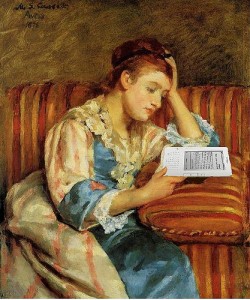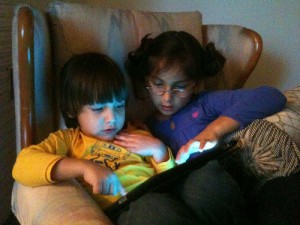Clarence Fisher recently wrote a post regarding digital reading. At the end of the post he states,
My reading habits are changing and some of it is due to the devices I have been using. The popularity of these devices is unquestionable, but they have the long history of paper to compete against. They are interesting, useful and easy to use. But can they change what and how we read? Do they make being literate different?
Recently this same topic has been on my mind. I received a Kindle at Christmas time. I enjoyed using it for many reasons.
- I appreciated the almost instant access to books that would be expensive to ship to Singapore or require a trip downtown.
- I liked the integrated reading light in the overpriced cover.
- The built-in dictionary was helpful.
- When travelling I found it useful to carry many books in such a small package.
- My tired night eyes appreciated that I could change the font size.
 Then I read a professional book on it. I could mark up the text, take notes and then sync those with my online account. Voilá! No more flipping through the book to find my highlights and notes. Instantly my notes became much more useful, much more powerful. In addition to my own highlights, I can optionally view what other readers have highlighted. This has further enhanced my reading experience. Now when a professional book isn’t available on Kindle, I grouse and am less likely to read it. All in all, the Kindle did add value to the reading experience and I was glad to own it.
Then I read a professional book on it. I could mark up the text, take notes and then sync those with my online account. Voilá! No more flipping through the book to find my highlights and notes. Instantly my notes became much more useful, much more powerful. In addition to my own highlights, I can optionally view what other readers have highlighted. This has further enhanced my reading experience. Now when a professional book isn’t available on Kindle, I grouse and am less likely to read it. All in all, the Kindle did add value to the reading experience and I was glad to own it.
Then I discovered that I could manually (or automatically for a fee) upload my Instapaper articles to the Kindle. I know from past experience that I am unlikely to spend time on my computer reading the articles I have saved to Instapaper. When I discovered that I could upload the files to the Kindle I read far faster and with more enjoyment.
However, all was not perfect. Adding notes was a tedious process. The reading light sometimes bothered my spouse. The Instapaper articles were “dead;” I couldn’t share them or save them on the Kindle. Most bothersome was needing to buy the reading material. I am a big fan of libraries and wanted to read library books on my Kindle. I know that feature is coming out later this year. I hope it isn’t a Windows-only thing as so many DRM things are.
This summer I purchased an iPad 2. I knew it was supposed to be a nice platform for reading, but I was more interested in it as a laptop replacement for use when traveling, teaching and in meetings. Therefore I was surprised to find how much it impacted my reading.
The first impact came from using Flipboard. I was able to enter my blogroll, Facebook and Twitter RSS feeds into the app. It’s newspaper-like layout made it a pleasure to read those feeds and easy to skim to find the posts I really wanted to read. The app’s sharing features made it easy for me to share links on Twitter, Google Reader or via email. I could retweet and reply to what I was reading. I could send articles to Instapaper. I even worked out a fairly painless procedure for getting links into Diigo. (I dearly wish there was direct integration with Diigo. That would save me even more time.) In short order, I went from 1000+ unread posts to being caught up each week.
Next I tried the Kindle app. Now reading professional books was even better because it was easier to add notes. I am more likely to have my ipad with me than my Kindle, so books are more often at hand.
Then I tried Zite. It is a news reader that allows you to pick areas of interest. Then, within those areas, you can give individual articles a thumbs up or down to train the app to better meet your interests. The layout and features are similar to Flipboard so reading is a pleasure. Not since I had a paper subscription to the International Herald Tribune have I read so much news and enjoyed it so much. Today I noticed that the app has added the feed from the Popular Science magazine website. An hour later I was still grinning as I read articles back through last December, everything from the theory of cancer as a parasite, not merely a cell mutation, to a photo from the International Space Station of the last space shuttle’s glowing vapor trail on its final descent.
 Then I discovered that the Ramsey County Library in my hometown in Minnesota has many books available for reading on your computer or your mobile device using Overdrive software from Adobe. More than 15,000 libraries world wide use that system. I needed to create a free Adobe account from the Adobe website. I also needed to download the Overdrive app and enter my Adobe ID into it. Then I used my library account which I already used to reserve and renew print books, to login. In a matter of minutes I had a book downloaded to my iPad.
Then I discovered that the Ramsey County Library in my hometown in Minnesota has many books available for reading on your computer or your mobile device using Overdrive software from Adobe. More than 15,000 libraries world wide use that system. I needed to create a free Adobe account from the Adobe website. I also needed to download the Overdrive app and enter my Adobe ID into it. Then I used my library account which I already used to reserve and renew print books, to login. In a matter of minutes I had a book downloaded to my iPad.
Patrons are allowed to have up to two ebooks checked out at a time. The lending time varies by book but most seem to be 2 week loans. Unlike most Kindle books, the layout was the same as the print book. Picture books are in full color. The first chapter book I read included page embellishments. I wish the Overdrive app had a built-in dictionary, but other than that, it has all the features I need. Their ebook collection is tiny compared to their print collection. Despite that, I have a long wishlist of books I plan to download and read.
Back to Clarence’s original questions. I haven’t exactly addressed them, but I can unequivocally say that for me, digital reading devices have me reading more, reading more broadly, sharing more of what I read, and making better use of my notes.
My own questions include the following:
- Will mobile reading devices have a similar impact on our students? I know for my elementary students that is unlikely since most of the apps mentioned above cannot be used by them since they are under 13.
- For older students, how can we leverage the power of these devices?
- I have been an avid reader since I was a child so my taking to these devices is no surprise. Will the diversity of materials readily available make reading more appealing to reluctant readers?
- Will they appeal to some reluctant readers because they are tech?
- Do we need to teach them different literacy skills to make the most of these devices?
Are you using ebooks or mobile devices with your students? Has it impacted their reading? Please share your experiences with me.
- Mrs. Duffee Seated on a Striped Sofa, Reading Her Kindle, After Mary Cassatt by Mike Licht, NotionsCapital.com used with permission under a Creative Commons Attribution 2.0 Generic license.
- Readingby Courosa used with permission under Creative Commons license
Attribution-NonCommercial-ShareAlike 2.0 Generic (CC BY-NC-SA 2.0)

Hey Susan,
Sorry about the off-topic comment, but I couldn’t find any contact info for you on the blog, and I wanted to ask about the possibility of a guest post. Please drop me an e-mail!
Thanks,
Lindsey
I really enjoyed reading this post. I happen to love the accessibility of digital reading and believe that it will soon, if it not already, become an integral part of how people live. My major concern regarding students is this: with ease of access, does the value of the written word decrease? Books are often cheaper, more likely to be marked up than a print copy. In the future, will getting published be a less intense process so that more work of less ‘quality’ is being produced? Thank you for your questions and your comments on the tech behind the different reading devices. So, helpful.
I’d be curious to see how both colleagues and students answer the questions that Clarence Fisher poses. It’s interesting that paper and digital text are presented as competing mediums. This is undoubtedly a current topic in regards to popularity of online news, as opposed to newspapers. I’ve been interested by studies conducted on the differences between reading digital and paper texts; this Mashable article links to a study from the University of Oregon School of Journalism & Communication: http://mashable.com/2011/08/22/print-vs-online-news/
Whilst a different medium means a different way of reading, I don’t think this involves one form replacing another. For example, I might happily read a graphic novel from our school library, but if I’d like to see the latest webcomics, I’ll go online. I see students making choices like this (our library also has a kindle which you can check out as you would a book); once a student asked me if he could read a ‘taster’ or preview chapter opening of a book on his iPhone. This was a great way to then help him decide whether to buy the book (in electronic or paper form). It was also an indicator of how new novels can perhaps have a greater chance of being published and bought, as they are more easily shared.
In his book ‘Hamlet’s Blackberry’, William Powers offers “practical philosophy for building a good life in the digital age”. At one stage he focuses on the change in reading. He reflects on historical changes in human communication, from the group gatherings at speeches in Ancient Greek society to consider that modern day digital reading may also be moving towards a group experience. Near the end of your post you note that you are now “sharing more” of what you read; this goes beyond the traditional book clubs of paper texts and perhaps in a sense, this responds to Fisher’s question about change.
Hi Lindsey,
Thank you for contacting me. At this time I am not accepting guest posts.
Hi from WBL! I’m brand new to blogs and you’re one of the first people I wanted to read. I’m just taking a class on blogs and wikis so I have no answers yet. I have learned so much already from just reading this post.
I’ll be blogging with my pc at home and school as well as my iPad. Anything I should be aware of using both platforms?
Hi Karla!
Great to hear from you. I’m honored to have you reading my blog. If you choose a robust blogging platform such as wordpress.com or blogger.com you should be able to edit and update your blog from your PCs and your iPad. Please send me the address when you start your blog!